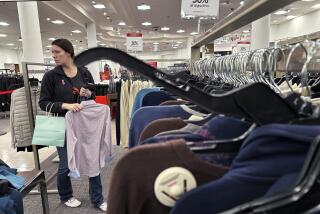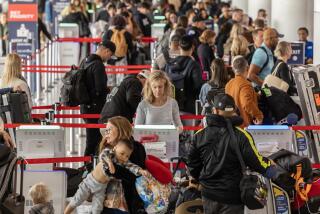Industrial Production Declines 0.3% : Economy: The June figures arrive as consumers seem increasingly reluctant to spend despite low interest rates.
- Share via
WASHINGTON — Industrial production fell in June for the first time in five months, pulled down by a drop in auto manufacturing and a two-day national rail shutdown, the government said Wednesday.
Production at the nation’s mines, factories and utilities fell 0.3% last month, the Federal Reserve said, while a separate Commerce Department report showed falling sales and rising inventories.
The figures come as consumers seem increasingly reluctant to spend despite the Fed’s efforts to spur the flagging recovery with historically low interest rates.
The drop in output was the first since production fell by 0.7% in January before posting four straight gains from February through May. The falloff in June was particularly notable in production of new cars, production supplies and energy products.
A two-day national rail shutdown late in the month sparked by a labor dispute was a factor because it made it hard to get goods such as coal to market, but the figures generally showed an economy losing steam to the point of risking a stall.
The point was reinforced by a Commerce Department report showing that business sales fell 0.2% in May, while inventories climbed 0.1% to their highest level since March, 1991.
“The figures reflect a distinct lessening of momentum since the first quarter, and that’s worrisome,” said economist Allen Sinai of Boston Co., who noted other evidence of slackening vitality at home and abroad.
“Exports have fallen in four of the past five months, capital spending is weak and auto production is highly volatile,” Sinai said. “Now we’re seeing weakness in Europe and Japan start to reverberate throughout our economy in the form of weaker sales to them.”
Factories operated at 78.5% of capacity in June, down from 78.9% in May, the Fed said.
Production for the second quarter as a whole--April, May and June--still grew at an annual rate of 4.5% in contrast to the first quarter, when it shrank by 2.9%.
But its decline in June only emphasized the contrary nature of the slow-paced recovery that policy-makers had hoped would be powering up by midyear instead of waning.
“What it shows is that we did not get a snap-back in the spring and that we have lower momentum entering the third quarter--exactly the opposite of what Washington was hoping for,” Sinai said.
Cars were being built at an annual rate of 6.1 million vehicles in June, down from 6.2 million in May.
While production rates for some long-lasting durable goods such as appliances and furniture were stronger in June than in May, output of many non-durable items, such as food and clothing, declined.
John Albertine, who runs a Washington-based consulting firm, said the production figures were “another piece of evidence that the recovery is losing its grip.”
“The recovery is not getting up any momentum,” he said. “There is no strong sector or even sub-sector that can give the economy a jump start.”
Consumers indicated in June that they were unlikely to prime the pump, boosting retail spending only by 0.5% and primarily because of more new car-buying by rental companies. Excluding cars, spending by consumers, who fuel two-thirds of economic activity, gained a fractional 0.1%.
Ken Ackbarali, an economist with First Interstate Bancorp in Los Angeles, said weaker industrial production fits with the rise in national unemployment during June to 7.8%.
Ackbarali said the political campaign season may be a negative influence on the economy.
The only realistic policy remedy, most economists say, is more interest-rate reductions because lawmakers won’t consider fiscal measures such as tax cuts when the deficit is so high and they are focused on keeping their jobs.
That means the Fed could be pressured into making credit cheaper if the economy keeps skidding.
“There’s no law against lower interest rates,” Sinai observed.
Industrial Production
Seasonally adjusted index, 1987 = 100
June, ‘92: 108.2
May, ‘92: 108.6
June, ‘91: 107.3
Capacity Utilization
Seasonally adjusted percent of total capacity
June, ‘92: 78.5%
May, ‘92: 78.9%
June, ‘91: 79.6%
Source: Federal Reserve Board
More to Read
Inside the business of entertainment
The Wide Shot brings you news, analysis and insights on everything from streaming wars to production — and what it all means for the future.
You may occasionally receive promotional content from the Los Angeles Times.










